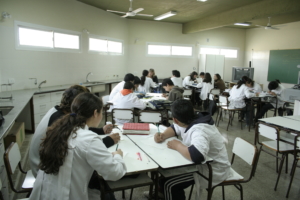10 Facts About Education in Argentina

Argentina was the seventh most prosperous nation in the world just a century ago, according to Agnus Maddison’s historic incomes database. In fact, its per capita income in 1909 was 50 percent higher than Italy and 180 percent higher than Japan. “The gap between 2000 income and predicted economic success, based on 1909 income, is larger for Argentina than for any other country,” according to New York Times’ Economix. In other words, income in Argentina is sharply declining. Much of the nation’s economic trouble can be attributed to shortcomings in their education system. Argentina’s education minister, Esteban Bullrich, says, “We don’t want to accept that we’re doing badly at anything.” While many of Argentina’s student academic goals are statistically high, other aspects of their education system have proved to be weak. Here are 10 facts about education in Argentina.
10 Facts About Education in Argentina
- Argentina’s quality of life is among the highest in South America. It is rated number 55 worldwide for quality of life and 40 in entrepreneurship. Due to this, many students have easy access to an education.
- Argentina’s literacy rate is 98.1 percent – a five percent increase since the 80s. More Argentinians are reading at a higher level now than ever before. In comparison, that is 12 percent higher than the global average.
- Argentina’s school year runs about 200 days. Students are in school from March to December with a two-week break during July and breaks on national holidays such as Easter. In contrast, American school years tend to run only 180 days a year. The Society for Research on Educational Effectiveness found through their study that longer school years can benefit students greater than longer school days. Shortened summers prevent “summer slide-back,” a phenomenon in which students forget learned information during summer breaks.
- In 2005, 12.2 million students made up 30 percent of Argentina’s population. In the early 2000s an economic crisis had a severe impact on those enrolled in school. Primary level enrollment fell from 117.8 percent to 112.7 percent. Despite this, school is mandatory in the nation.
- School runs for just four hours a day, Monday through Friday, with a student either attending an 8:15- 12:15 session or a 13:00 to 17:15 session. In contrast, American schools average six and a half hours a day and schools in China run from 7:30 a.m. to 5 p.m. with a two-hour lunch break. A study conducted by the Department of Education in Massachusetts found that longer school days can improve test scores by 4.7-10.8 percentage points
- As of 2016, Argentina has a secondary school enrollment rate of 90 percent, according to the World Bank. Secondary education is broken into a basic cycle of 3 years followed by a cycle of two to three years where students can study accounting, computer science, and other various specializations. Technical-vocational programs include 12-15 hours a week in workshops.
- Only 27 percent of students in Argentina finish their university studies. This gives the nation a drop-out rate of 73 percent – one of the highest in the world. Esteban Bullrich, the education minister says that only about half of students finish their secondary studies.
- The Minister of Education in Argentina refused César Alan Rodríguez, a student with down syndrome, his graduation certificate, arguing he had received an adaptive curriculum. Rodriguez was the only disabled student attending his school at the time. In response, he sued his school for discrimination of basis of disability. Argentina ruled in this case to start taking the education of disabled students seriously, creating the Convention on the Rights of Persons with Disabilities (CRPD). CRPD is the first human rights treaty clearly stating all students have an equal right to education regardless of ability.
- A teacher’s gross salary in Argentina is $10,747 in American currency. This number is roughly a fifth of what teachers make in the United States. In contrast, Regional IT Managers in Argentina make $134,336 and Software Engineers make $55, 535 on average.
- Argentina’s Ministers of Education met at the G20 Summit on September 5th, 2018 to create an action plan. There the ministers pledged to keep up with societal and technological innovations, better equip teachers, “[promote] multiple and flexible pathways into lifelong education and training,” improve policies, and engage students. Furthermore, they discussed how to finance these goals in line with the United Nations’ 2030 Agenda.
Like the rest of the world, education in Argentina is not perfect. Drop-out rates run high and school days run short. However, the nation is making a clear effect to improve the situation for students and educators across their country.
– Maura Byrne
Photo: Flickr
